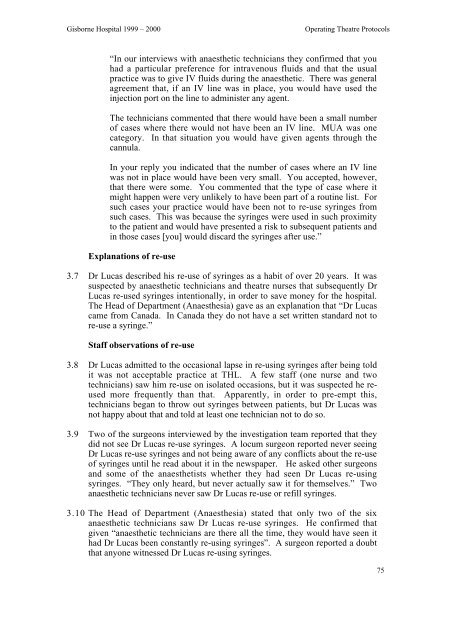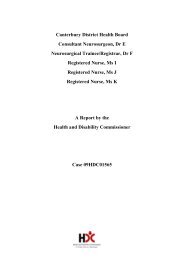Gisborne Hospital Report - Health and Disability Commissioner
Gisborne Hospital Report - Health and Disability Commissioner
Gisborne Hospital Report - Health and Disability Commissioner
Create successful ePaper yourself
Turn your PDF publications into a flip-book with our unique Google optimized e-Paper software.
<strong>Gisborne</strong> <strong>Hospital</strong> 1999 – 2000<br />
Operating Theatre Protocols<br />
“In our interviews with anaesthetic technicians they confirmed that you<br />
had a particular preference for intravenous fluids <strong>and</strong> that the usual<br />
practice was to give IV fluids during the anaesthetic. There was general<br />
agreement that, if an IV line was in place, you would have used the<br />
injection port on the line to administer any agent.<br />
The technicians commented that there would have been a small number<br />
of cases where there would not have been an IV line. MUA was one<br />
category. In that situation you would have given agents through the<br />
cannula.<br />
In your reply you indicated that the number of cases where an IV line<br />
was not in place would have been very small. You accepted, however,<br />
that there were some. You commented that the type of case where it<br />
might happen were very unlikely to have been part of a routine list. For<br />
such cases your practice would have been not to re-use syringes from<br />
such cases. This was because the syringes were used in such proximity<br />
to the patient <strong>and</strong> would have presented a risk to subsequent patients <strong>and</strong><br />
in those cases [you] would discard the syringes after use.”<br />
Explanations of re-use<br />
3.7 Dr Lucas described his re-use of syringes as a habit of over 20 years. It was<br />
suspected by anaesthetic technicians <strong>and</strong> theatre nurses that subsequently Dr<br />
Lucas re-used syringes intentionally, in order to save money for the hospital.<br />
The Head of Department (Anaesthesia) gave as an explanation that “Dr Lucas<br />
came from Canada. In Canada they do not have a set written st<strong>and</strong>ard not to<br />
re-use a syringe.”<br />
Staff observations of re-use<br />
3.8 Dr Lucas admitted to the occasional lapse in re-using syringes after being told<br />
it was not acceptable practice at THL. A few staff (one nurse <strong>and</strong> two<br />
technicians) saw him re-use on isolated occasions, but it was suspected he reused<br />
more frequently than that. Apparently, in order to pre-empt this,<br />
technicians began to throw out syringes between patients, but Dr Lucas was<br />
not happy about that <strong>and</strong> told at least one technician not to do so.<br />
3.9 Two of the surgeons interviewed by the investigation team reported that they<br />
did not see Dr Lucas re-use syringes. A locum surgeon reported never seeing<br />
Dr Lucas re-use syringes <strong>and</strong> not being aware of any conflicts about the re-use<br />
of syringes until he read about it in the newspaper. He asked other surgeons<br />
<strong>and</strong> some of the anaesthetists whether they had seen Dr Lucas re-using<br />
syringes. “They only heard, but never actually saw it for themselves.” Two<br />
anaesthetic technicians never saw Dr Lucas re-use or refill syringes.<br />
3.10 The Head of Department (Anaesthesia) stated that only two of the six<br />
anaesthetic technicians saw Dr Lucas re-use syringes. He confirmed that<br />
given “anaesthetic technicians are there all the time, they would have seen it<br />
had Dr Lucas been constantly re-using syringes”. A surgeon reported a doubt<br />
that anyone witnessed Dr Lucas re-using syringes.<br />
75
















